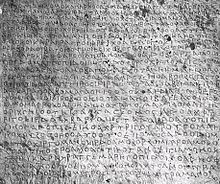Authors Afghan Historians
7 days
30 days
All time
Recent
Popular
#Kanishka I was, the greatest, and certainly the most famous, of the #Kushan kings.
He is known, from the combined testimony of the literary, epigraphic, and numismatic sources, to have ruled over an extensive dominion extending from Bihar in the east to #Khorasan
@atalbrave https://t.co/o9dOqR8bDg

in the west, and from #Khotan in the north to, perhaps, #Konkan in the south.
The dates and findspots of some of the inscriptions of #Kanishka I are interesting:
#Kosam inscription dated year 2,
#Sarnath inscription dated year 3,
#Mathur¹ inscription dated year 4,
#Suivihar inscription dated year 11, and
#Manikiala inscription dated year 18.
#AFG

Kanishka I, belonged to the Little #Yüeh-chih branch settled in Tibet, entered #India through #Kashmir.
He carved out a principality for himself somewhere in #UttarPradesh, sometime after the death of V’ima #Kadphises.
He then extended his sway towards the west and the northwest.
However, the recently discovered #Rabatak inscription #SurkhKotal shows that he was, in fact, the son and successor of V’ima Kadphises.
Kanishka I attained several military successes in the east.

He is known, from the combined testimony of the literary, epigraphic, and numismatic sources, to have ruled over an extensive dominion extending from Bihar in the east to #Khorasan
@atalbrave https://t.co/o9dOqR8bDg

Now, #Kanishka, sometimes known as the great, the most celebrated of #Kushans, the founder of his own era, the great conqueror, the \u2018inventor\u2019 of #Bactrian writing. This will be a language & coin galore. #Afghanistan 1/ kr pic.twitter.com/Ji30OIIZiI
— Afghan Historians (@AfghanHistorian) August 10, 2019
in the west, and from #Khotan in the north to, perhaps, #Konkan in the south.
The dates and findspots of some of the inscriptions of #Kanishka I are interesting:
#Kosam inscription dated year 2,
#Sarnath inscription dated year 3,
#Mathur¹ inscription dated year 4,
#Suivihar inscription dated year 11, and
#Manikiala inscription dated year 18.
#AFG

Kanishka I, belonged to the Little #Yüeh-chih branch settled in Tibet, entered #India through #Kashmir.
He carved out a principality for himself somewhere in #UttarPradesh, sometime after the death of V’ima #Kadphises.
He then extended his sway towards the west and the northwest.
However, the recently discovered #Rabatak inscription #SurkhKotal shows that he was, in fact, the son and successor of V’ima Kadphises.
Kanishka I attained several military successes in the east.

